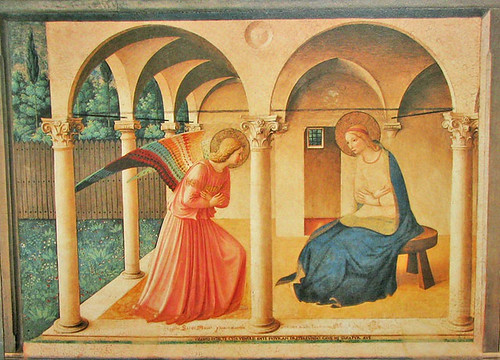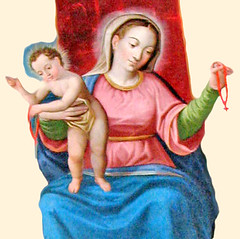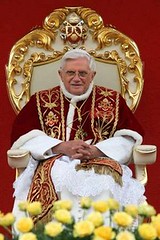Mary's Fiat and Fra Angelico

Like many of the greatest painters, Beato Angelico had a predilection for depicting the Annunciation, that momentous event when Mary's Fiat opened the way to salvation. However, his was no mere compliance with an artistic convention, just as some music composers today write music for the Latin Mass, because it is something every great composer does, but do not themselves believe a word of it! Rather, Fra Angelico placed "his genius at the disposal of a badly needed renewal of evangelical preaching, through the beauty of his painting. It is not going too far to emphasize the fact that art was, for him, the prime medium of preaching, and that his painting should be seen in this light" (Guy Bedouelle, OP, In the Image of St Dominic, 75-76). As such, we ought to examine what one such Annunciation, from the San Marco North Dormitory and painted around 1450, has to say. Artistically, the composition of this scene is credited to Fra Angelico and it was to become typical of 15th-century Florentine Annunciation scenes. It's location is also unique - it was placed outside the enclosure of the convent and hence open to public view, as is fitting for something preached to the world.
For a Dominican friar, this scene has special significance, both in the sacra conversatio, the sacred dialogue between the angel and the Blessed Virgin, which is at the heart of contemplation and in the attitude of Our Lady who listens with humility to God's divine plan and makes herself entirely available to His will; Mary's total gift of self is an act of Love which every friar wishes to emulate. Moreover, she is the one who bears the Word in her womb, contemplating Him in herself, as it were, so as to give Him to the world. So too, the friar who contemplates the Living Word, Jesus Christ, does so in order to communicate Him on to others. For Mary is "the model of the creature living in perfect friendship with God in the midst of the joys and sufferings that mark salvation history" (ibid., 77). In addition, the Annunciation reminds us that God took flesh of the Virgin Mary for our redemption; the truth of the Incarnation is central for the Order established to preach the goodness of God's creation against the dualistic heresies that plague the Church. Indeed, Bedouelle states that Fra Angelico's painting "never ceases to speak of the Incarnation" (ibid).
The Blessed Virgin Mary obviously has a key role in speaking of the Incarnation, hence I mentioned yesterday that she is one of the main figures in Dominican art. We have seen too the Order's great devotion to Our Lady and this manifests itself in the Salve Procession, the tradition that she designed the Habit and the belief that the Order was the answer to her pleas with Christ to spare a sinful world by raising up an Order of Preachers and other customs. However, William Hood adds an interesting detail that I have not seen elsewhere: "the highest authority in a Dominican convent was not the prior, but the abbess, who was the Virgin Mary herself, the mother of all the brethren alike" (Fra Angelico at San Marco, 271). As such here, in the lay brothers' dormitory, was a figure of the Mother of the Order and the angel Gabriel kneeling before her would remind the friar of her pre-eminent position and also of his own homage made to Our Lady at his Profession.
In addition, the inscription below the painting (translated from Latin) actually says: "When you come before the image of the Ever-Virgin take care that you do not neglect to say an Ave." Thus, the friar who saw this painting would echo the angelic salutation and according to a Dominican custom, genuflect when saying the 'Hail Mary' and thus directly imitate the angel in posture and word. Hence, the painting in the north corridor had a quasi-liturgical function.
Yet, the Blessed Virgin is depicted here not as a Queen but a simple maid, seated on a stool. This is in contrast to the altarpiece we examined yesterday which has her seated in royal estate. Here, her countenance is open and expectant; this is the Virgin at the very beginning of becoming the Mother of God. She gazes at the angel with beauty and tenderness, a look of contemplation on her guileless face. It is noteworthy that the Virgin's body casts a small shadow on the ground behind her stool... however the angel casts no shadow. This is a theological point - for the angel is spirit and has no true body as such, but the Blessed Virgin is fully human and embodied, a reminder again that God takes flesh and humanity from her body. Note also how large she is in proportion to the angel and the buildings; after all, she is seated! This exaggeration is deliberate to emphasise her presence and her importance. Clearly Mary is the focus of this scene and rightly so, for all her attributes which I mentioned above. Bedouelle notes that Mary's size may also serve to show that she herself is the True House, the holy Dwelling place of God and Temple of the Living God. This latter point is emphasised by the inscription above the one already noted. It reads: "Salve Mater Pietatis et Totius Trinitatis Nobilis Triclinium", 'Hail Mother of Compassion and noble resting-place of the whole Trinity', a strophe from a sequence hymn by Adam of St Victor.
The scene takes place beside an enclosed garden which is again a Patristic symbol of Mary. The flowers of red and white "evoke the whole exegesis of the Song of Songs" (Bedouelle, 80). This is another innovation as the Annunciation was typically painted with Our Lady seated and (often) reading in her bedroom, the bridal chamber of the Virgin Spouse. However Fra Angelico depicts her in the porch next to the garden as if to suggest the cloister garden where contemplation and recreation took place. The garden also alludes to Eden, whence Eve's disobedience has now been overturned by Mary's Fiat. Leonardo da Vinci was to imitate Fra Angelico's composition in his famous Lourve Annunciation, although he does not place her in so clearly an enclosed garden.
It has been suggested by William Hood that Our Lady is dressed here in black and white, the colours of the Dominican habit. I am inclined to agree because Fra Angelico's depictions of Dominican friars in their habits in the San Marco frescoes all have the same blue-ish tint that is evident here and Mary is always painted elsewhere in the convent with a red tunic. The architecture of Our Lady's porch where she sits and the cell behind her also echoes the architecture of the Priory of San Marco. All these serve to indicate that the friar ought to identify himself with Our Lady and the Dominican is invited to see in her openness to God's will and her eagerness to serve God a perfect example for him to follow, even as he meditates in his cell and contemplates the Word of God.
Thus, Pope Pius XII said in 1955 that "as he narrates or expounds the sacred mysteries to his audience, Fra Angelico is ever the skillful 'preacher', seeking to elicit an immediate response with descriptive and decorative elements in order to speak more quietly to the inmost soul. On one hand his purpose is to teach the truths of the faith, convincing human minds by the very force of their beauty. On the other he aims to lead the faithful to the practice of Christian virtues by setting before them beautiful and attractive examples."
Clearly there can be no more beautiful an example than Our Lady and the Angelic Friar preaches her beauty and virtues with eloquence both in his paintings and in his holiness of life:
"God of eternal beauty,
by your ineffable grace Fra Angelico
studied and taught the mystery of your Word.
With the help of his prayers
may we be led at last to contemplate
the radiance of your mystery face to face.
Through Christ our Lord."
Amen.







3 Comments:
If you're ever in Peoria, IL, St. Mark's Church has been transformed into a shrine to Fra Angelico. It is definitely worth the trip from Chicago or St. Louis (3hours drive south or north). Here's a few photos...
http://www.muralsbyjericho.com/murals/murals.htm
Absolutely splendid! Wow! I am so envious... Except I must note: the website calls itself the Shrine of "Blessed Fra Angelica"! Is this Mother Angelica of EWTN transmuted with Blessed John of Fiesole?!
Dear Br. Lawrence, I so much enjoyed reading your notes on Fra Angelica's work. I love to 'read' icons, and so it was a total pleasure to find your website on Fra Angelica, whose work I love so much too. God bless you. Lisa, Ireland.
Post a Comment
<< Home